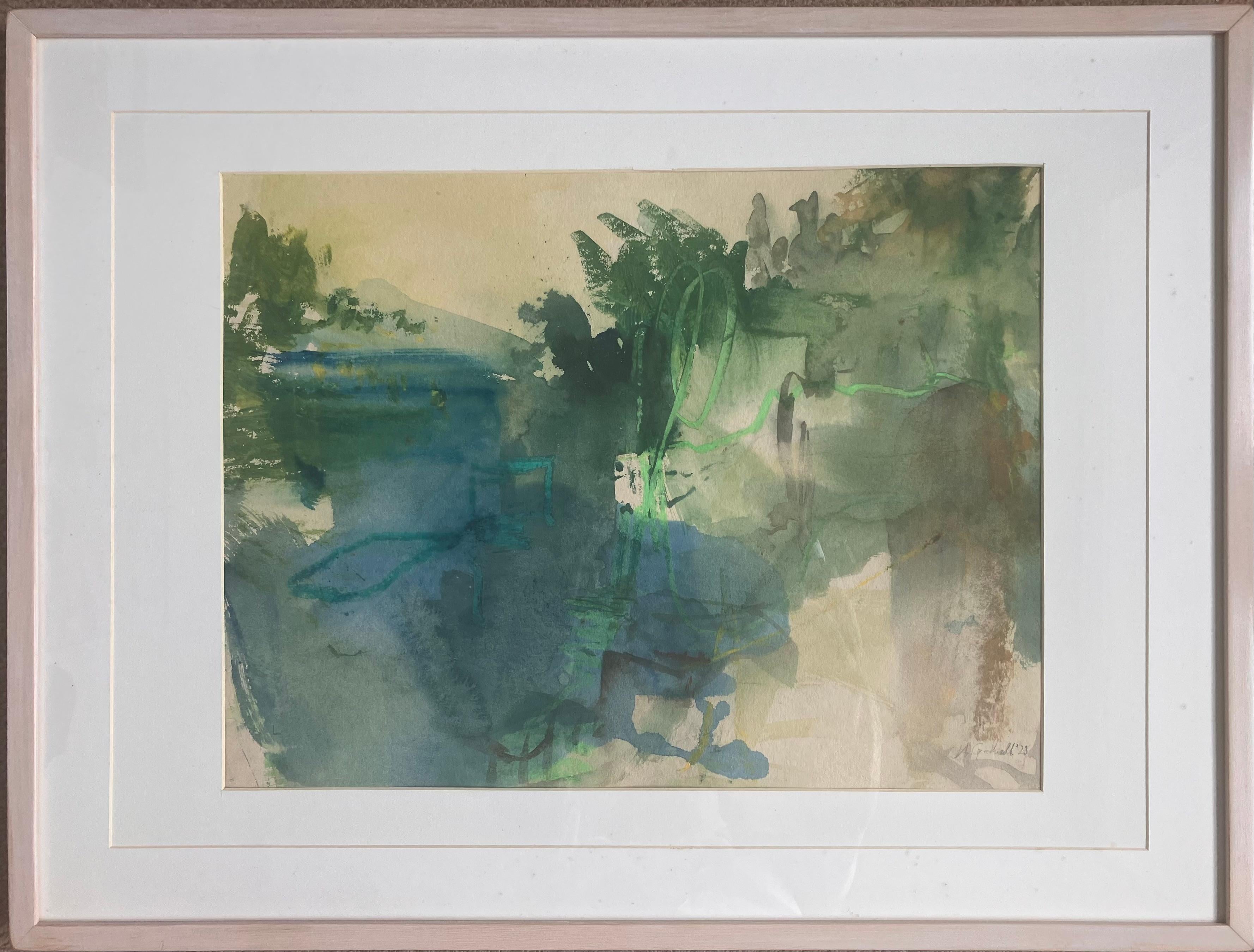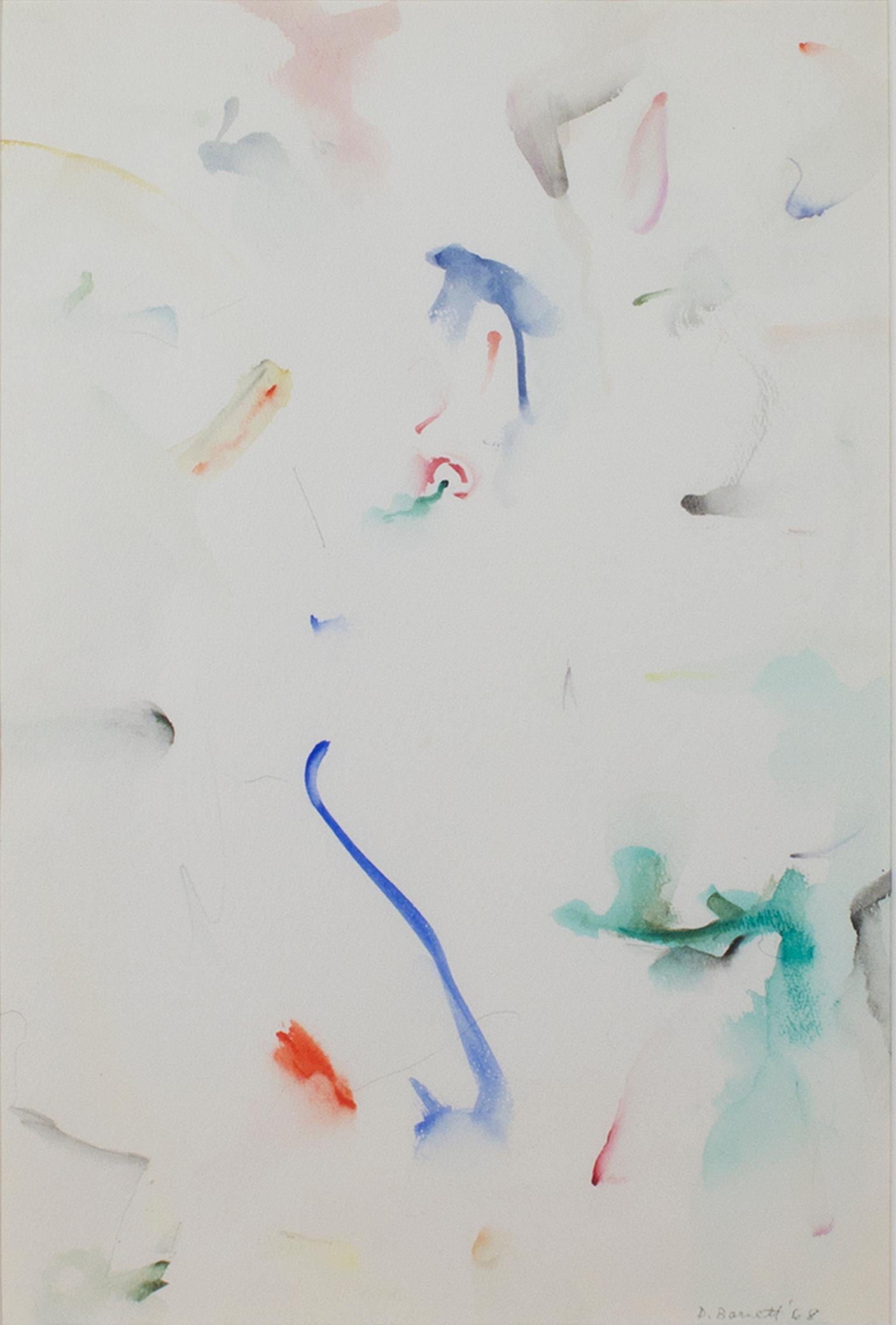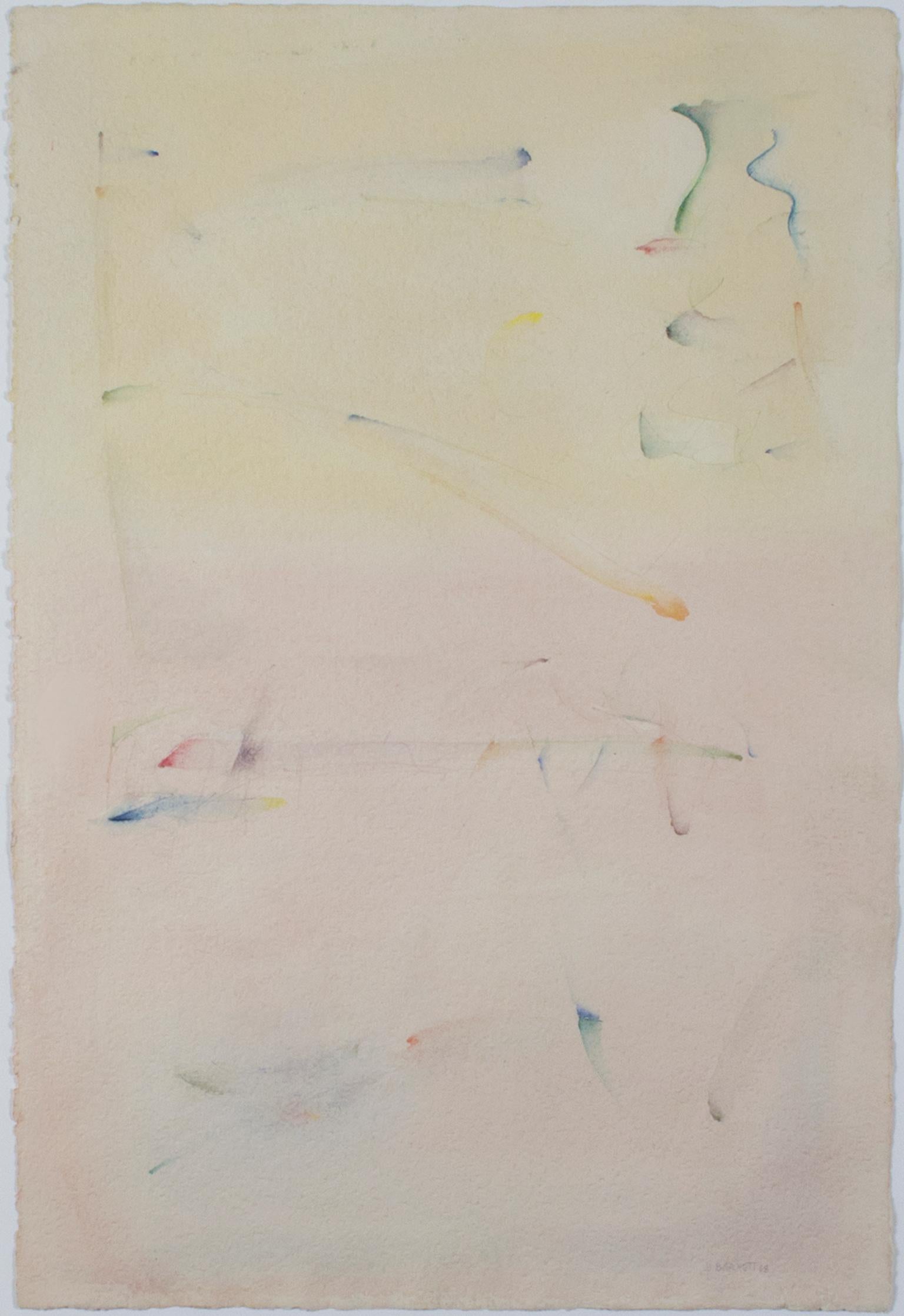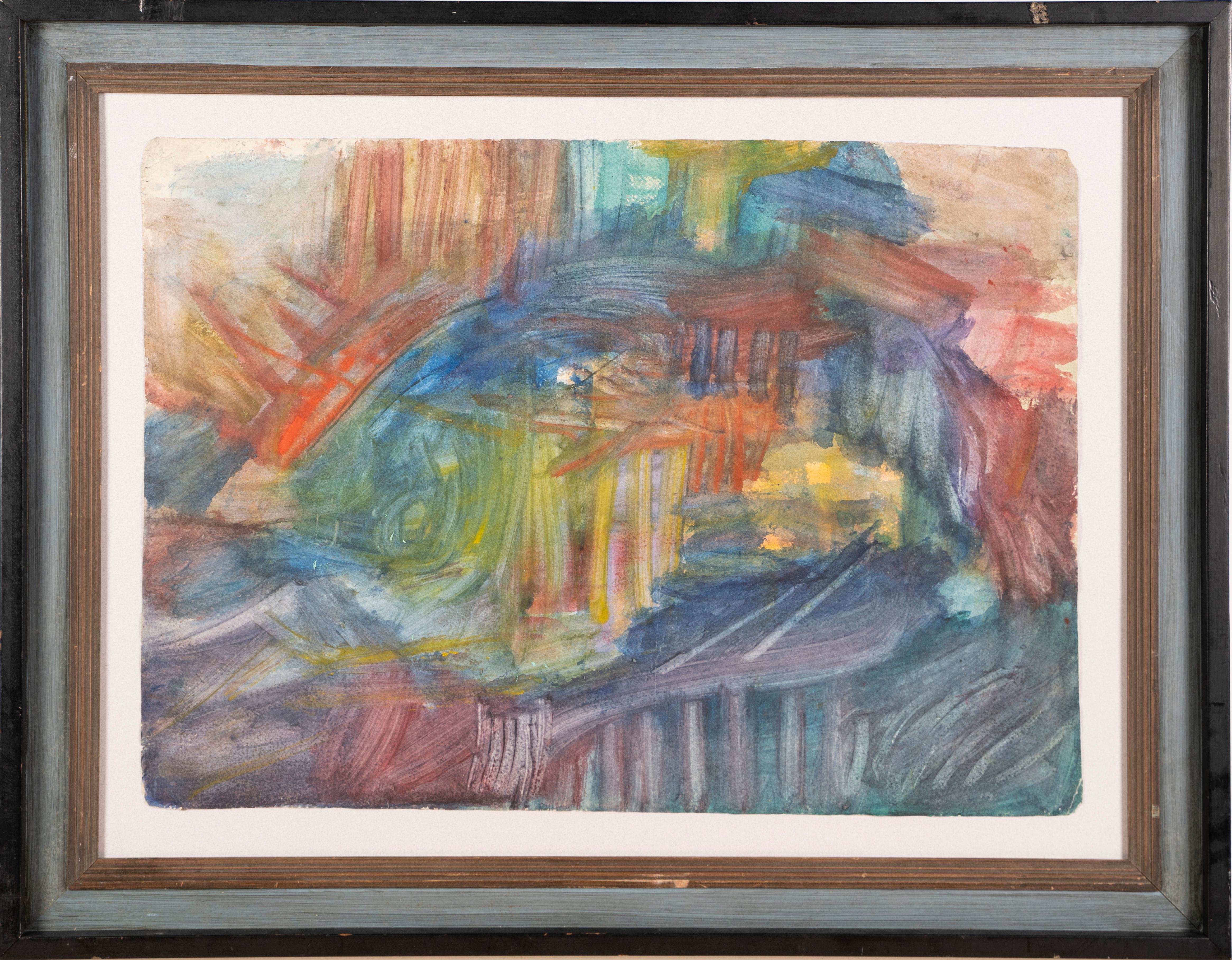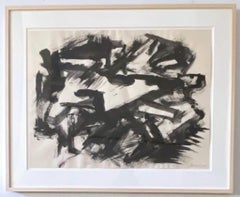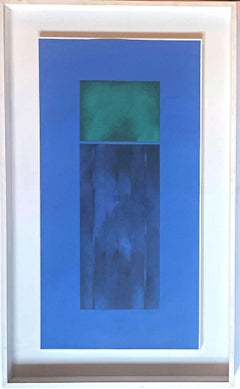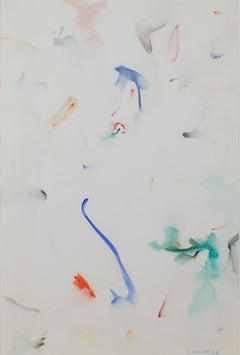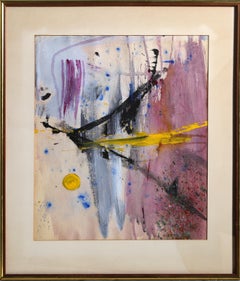Items Similar to Walter Darby Bannard, Ammersee #2 signed painting by renowned Color Field artist
Want more images or videos?
Request additional images or videos from the seller
1 of 8
Walter Darby BannardWalter Darby Bannard, Ammersee #2 signed painting by renowned Color Field artist1975
1975
$8,000
£6,034.07
€6,969.41
CA$11,208.55
A$12,463.27
CHF 6,524.74
MX$152,241.12
NOK 81,989.84
SEK 77,127.88
DKK 52,026.14
About the Item
Walter Darby Bannard
Ammersee #2, 1975
Watercolor and acrylic painting on paper
Signed, titled and dated lower recto
This is a unique work
Frame included: elegantly floated and framed in a museum quality wood frame with UV plexiglass
The present work, Ammersee #2, refers to the German name for Lake Ammer in Upper Bavaria, Germany, southwest of Munich between the towns of Herrsching and Dießen am Ammersee - the sixth largest lake in Germany. (Like other Bavarian lakes, Ammersee developed as a result of the ice age glaciers melting.)
Abstract Expressionist and Color Field artist Walter Darby Bannard was a distinguished professor of art, Hans Hofmann scholar, and longtime friend and scholar of Frank Stella. At a New York gallery talk, Frank Stella mentioned Bannard as an artist whose work he collected.
Measurements:
Frame:
23 inches x 28.5 inches
Artwork itself:
18.5 inches x 23.25 inches
This work is floated and framed in an elegant wood frame with UV plexiglass in accordance with museum conservation standards.
Walter Darby Bannard was a Color Field painter whose elegant, severe abstract paintings of the late 1950s and early ’60s were the springboard for a lifetime’s exploration of color, form and the physicality of paint.
Mr. Bannard, whose keen critical intelligence was reflected in his many essays on art, spent more than half a century elaborating and revising the distillation of color and form that made him an important voice in the nascent Color Field movement, sometimes called post painterly abstraction.
Soon after graduating from Princeton, where he found common cause with the painter Frank Stella and the critic Michael Fried, he experimented with swirling, turbulent paintings, using new materials like alkyd resin, before arriving at a refined minimalism that confronted viewers with an isolated, luminous geometric form — usually a disc or a square — hovering over a single-color ground.
The critic Clement Greenberg included him in the pivotal show “Post Painterly Abstraction” at the Los Angeles County Museum in 1964, and the Museum of Modern Art showed his work the following year in “The Responsive Eye.” Bannard was on his way.
Over the years, he ventured into new territory, dissolving the geometry of his early painting, loosening the brushwork and complicating his surfaces with polymers and gels that lent a topographic quality to his work; it often suggested a strange landscape seen from a great height. In every phase, Bannard showed a subtle color sense all his own, and a knack for deploying his forms in a slightly unnerving way, keeping viewers captivated and off-balance.
Walter Darby Bannard, usually called by his middle name, was born on September 23, 1934, in New Haven. His father, Homes, was a railroad manager who moved the family often from one assignment to the next, to New Jersey and, during World War II, to Washington. His mother, Janet Darby, was a homemaker.
His taste for modernism surfaced early. At 11 he noticed, in the color section of a Sunday newspaper, a clown painting and a reproduction of a painting by the British abstractionist Ben Nicholson, with the question “Which kind of art do you like?” He voted for Nicholson, the butt of the joke. “I said to myself, well, I sure know what I like,” he told Artcritical. “In fact I’m going to cut it out and put it in my wallet.”
After graduating from Phillips Exeter Academy, Mr. Bannard enrolled in Princeton, where he earned a bachelor’s degree in philosophy in 1956. At college he became absorbed in painting and soon began experimenting in the manner of Mark Rothko and Clyfford Still. An exhibition by the American abstract painter Barnett Newman suggested to him that his urge to focus on a simple, central image was correct. “That told me that I had permission to do what I was doing,” he told Artcritical.
He had his first solo show at the Tibor de Nagy Gallery in 1965. In 1973 the Baltimore Museum of Art organized a retrospective exhibition that traveled to the High Museum of Art in Atlanta and the Museum of Fine Arts in Houston.
Like many of his Color Field contemporaries, Mr. Bannard embraced new mediums that allowed him to expand his visual vocabulary. First came alkyd resins, then acrylics, applied with rollers and rags. Later he adopted tinted gels and polymers, which he applied with squeegees and, in the “brush and cut” series he began in the late 1980s, commercial floor brooms. He began thinking of color, he said in a 1990 catalog essay, “as a liquid, flowing over and settling on a roughened surface, changing as it mixed and dried.”
As a critic and commentator, Mr. Bannard wrote frequently for Art in America, Art International and other publications. In 1976 he organized and wrote the catalog for a retrospective of the work of Hans Hofmann at the Hirshhorn Museum and Sculpture garden in Washington. In 1989 he became chairman of the art department at the University of Miami.
After a period of neglect, Mr. Bannard began attracting renewed attention in the last decade when the Berry Campbell Gallery presented shows of his earlier work. “These colors are still radiant,” the critic Phyllis Tuchman wrote in Artforum, reviewing work from the late 1950s and early 1960s exhibited last year. “And the artist’s pale palette is as uniquely personal today as it was fifty years ago. You can’t even apply a name to his hues.”
- Creator:Walter Darby Bannard (1934, American)
- Creation Year:1975
- Dimensions:Height: 23 in (58.42 cm)Width: 28.5 in (72.39 cm)Depth: 1.5 in (3.81 cm)
- Medium:
- Movement & Style:
- Period:
- Condition:In good condition other than overall minor, unobtrusive waviness to sheet. Elegantly floated and framed in museum conservation wood frame.
- Gallery Location:New York, NY
- Reference Number:1stDibs: LU1745216212002
Walter Darby Bannard
Bannard is known for his lyrical abstraction, minimalism, and color field paintings. Exhibition: Pasadena Art Museum 1973.
About the Seller
5.0
Platinum Seller
Premium sellers with a 4.7+ rating and 24-hour response times
Established in 2007
1stDibs seller since 2022
449 sales on 1stDibs
Typical response time: 2 hours
- ShippingRetrieving quote...Shipping from: New York, NY
- Return Policy
Authenticity Guarantee
In the unlikely event there’s an issue with an item’s authenticity, contact us within 1 year for a full refund. DetailsMoney-Back Guarantee
If your item is not as described, is damaged in transit, or does not arrive, contact us within 7 days for a full refund. Details24-Hour Cancellation
You have a 24-hour grace period in which to reconsider your purchase, with no questions asked.Vetted Professional Sellers
Our world-class sellers must adhere to strict standards for service and quality, maintaining the integrity of our listings.Price-Match Guarantee
If you find that a seller listed the same item for a lower price elsewhere, we’ll match it.Trusted Global Delivery
Our best-in-class carrier network provides specialized shipping options worldwide, including custom delivery.More From This Seller
View AllThomas Anderson Abstract Expressionist painting on paper, unique, signed, Framed
By Thomas Anderson
Located in New York, NY
Thomas Anderson
Abstract Expressionist painting on paper, ca. 1987
Mixed media watercolor, gouache and marker on paper
Signed in black marker lower right front
Unique
Frame included
...
Category
1980s Abstract Expressionist Mixed Media
Materials
Paper, Watercolor, Gouache, Permanent Marker
Untitled '71 Abstract Expressionist drawing. Signed by renowned sculptor, Framed
Located in New York, NY
Anthony Padovano
Untitled Abstract Expressionist drawing, 1971
Ink wash on paper drawing
Signed and dated in ink wash
Unique
Original (unique) signed Abstract Expressionist ink wash ...
Category
1970s Abstract Expressionist Abstract Drawings and Watercolors
Materials
Ink
Abstract Expressionist work on paper signed & inscribed to Norman Carton, Framed
Located in New York, NY
William H. Littlefield
Abstract Expressionist work on paper, for Norman Carton, 1962
Mixed media oil painting on paper
Signed William H. Littlefield, dated 9/16/1962 and inscribed, "...
Category
1960s Abstract Expressionist Mixed Media
Materials
Paper, Mixed Media, Oil
Portico, painting on masonite, Signed, Estate of gallerist Andre Zarre, Framed
By Sonia Gechtoff
Located in New York, NY
Sonia Gechtoff
Untitled portico, from the estate of gallerist Andre Zarre, 1977
Acrylic and graphite on masonite
Signed and dated '77 in graphite on the front
Unique
Provenance: Acqu...
Category
1970s Abstract Abstract Paintings
Materials
Masonite, Acrylic, Graphite
Rafina II Greece (Kasmin London label) Signed 1961 painting color field artist
By Paul Feeley
Located in New York, NY
Paul Feeley
Rafina II Greece, 1961
Watercolour on paper
Hand Signed, titled and dated lower front
In 1961, color field painter Paul Feeley created a series of watercolors - Rafina an...
Category
1960s Color-Field Landscape Drawings and Watercolors
Materials
Watercolor, Graphite
Spirit (mid century modern abstract painting by artist daughter of MOMA founder)
Located in New York, NY
Victoria Barr
Spirit, 1974
Crayon on Paper
Signed and dated lower right front
Frame included
Provenance: Fischbach Gallery, New York, NY
This bright, abstract 1970s artwork was created by Victoria Barr, daughter of the legendary developer of the Museum of Modern Art, Alfred H. Barr. There is a Fischbach Gallery label on the back of the frame. The Fischbach Gallery was, for many years, the gallery of record for the American artist Alex Katz. It is not easy finding Barr's work on the market at this time.
Measurements:
Framed:
23 inches x 29.5 inches x .5 inches
Artwork:
23 inches x 29 inches
Victoria Barr was born in New York, NY, in 1937 to the legendary MOMA curator and art historian Alfred H. Barr, Jr. and art historian Margaret Scolari Barr. Barr often traveled to Europe with her parents from the age of 14 onwards, meeting influential artists like Pablo Picasso, Henri Matisse, and Marc Chagall and collectors like Peggy Guggenheim. For high school, she went to Milton Academy...
Category
1970s Abstract Abstract Paintings
Materials
Oil Crayon, Graphite
You May Also Like
'Near Naples, Italy', mixed media signed original painting c2023
Located in Frome, Somerset
'Near Naples' , mixed media original painting by Andy Grdwell , circa 2023.
mixed media on paper 41cmx 55cm
Hardwood lime wax glazed frame: 63cm x 83cm.
Plien aire study of dwellings...
Category
2010s Abstract Expressionist Abstract Paintings
Materials
Mixed Media
"Abstract Landscape, " Original Abstract Watercolor signed by David Barnett
By David Barnett
Located in Milwaukee, WI
"Abstract Landscape" is an original watercolor painting by David Barnett, signed in the lower right corner. It is a playful piece, characterized by lines and splotches of color, high...
Category
1960s Abstract Abstract Drawings and Watercolors
Materials
Watercolor
Abstract Composition, Gouache and Watercolor by Stan Brodsky
By Stan Brodsky
Located in Long Island City, NY
Abstract Composition
Stan Brodsky
American (1925–2019)
Gouache and Watercolor on Paper
Size: 17 x 14.5 in. (43.18 x 36.83 cm)
Frame Size: 23 x 20.25 inches
Category
1980s Abstract Expressionist Mixed Media
Materials
Watercolor, Gouache
"Land, Sea, & Sky, " Original Abstract Watercolor signed by David Barnett
By David Barnett
Located in Milwaukee, WI
"Land, Sea & Sky" is an original watercolor painting by David Barnett, signed in the lower right. This gestural, abstract piece features two lightly washed color fields: yellow on th...
Category
1960s Abstract Abstract Drawings and Watercolors
Materials
Paper, Watercolor
Antique American Modernist Abstract Landscape Morris Shulman Signed Painting
By Morris M. Shulman
Located in Buffalo, NY
Vintage American modernist abstract Maine landscape painting. Watercolor and gouache on paper, circa 1960. Signed on verso. Image size, 30...
Category
1950s Abstract Landscape Paintings
Materials
Canvas, Oil
Abstract Composition
By Cornelia Schulz
Located in San Francisco, CA
This artwork "Abstract Composition" c.1990 is an acrylic paint on paper by American artist Cornelia Schulz, b.1936. It is signed at the lower right corner. The artwork size is 14.25 x 8.35 inches, paper size is 16.15 x 10 inches, framed size is 24.25 x 15.75 inches. Custom framed in a wooden white wash color frame, with off white matting. It is in excellent condition.
About the artist.
Cornelia Schulz (b. 1936) lives and works in the San Francisco Bay Area. For close to 50 years she has honed her skills in abstract paintings of complex shape and color. Her early education in the arts began at the Los Angeles County Art Institute in 1954 through 1957, the heyday of the California Ceramics Revolution. She studied sculpture in clay and wood with Renzo Fenci (1914 – 1999), and drawing from Herbert Jepson (1908 –1993). She received her Bachelor of Fine Arts in painting (1959) and her Master of Fine Arts in welded steel sculpture (1961) from the San Francisco Art Institute (SFAI).
Schulz began her teaching career at the University of California Davis Art Department in 1973, retiring as Professor Emeritus in 2002. During her tenure at the University of California in Davis, Cornelia Schulz became the first female Chair...
Category
Late 20th Century Abstract Abstract Drawings and Watercolors
Materials
Acrylic
More Ways To Browse
Artist Paint Brushes Used
World War 2 Paintings
Mark Rothko Signed
Used Railroad Signs
Mr Frank
Vintage German Newspaper
Refer A Friend
Clown Drawing
Frank Stella Signed
Painting Signed By Berry
Mark Newman
Southwest Sculpture
Vintage Bavarian
Bavarian Paintings
Glacier Painting
Clown Sculpture
Frank Newman
Abstract Clown Painting
